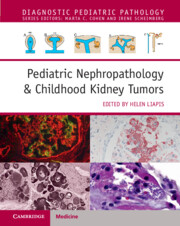Book contents
- Pediatric Nephropathology & Childhood Kidney Tumors
- Diagnostic Pediatric Pathology
- Pediatric Nephropathology & Childhood Kidney Tumors
- Copyright page
- Dedication
- Contents
- Contributors
- Preface
- Section 1 Normal and Abnormal Human Kidney Development
- Section 2 Glomerular Diseases
- Chapter 3 Idiopathic and Hereditary Proteinuric Glomerular Diseases
- Chapter 4 Haematuric Glomerular Diseases (Collagenopathies)
- Chapter 5 Immune Complex Mediated Glomerular Diseases
- Chapter 6 Inherited Metabolic Diseases Affecting the Kidney
- Chapter 7 Glomerular Diseases with Fibrillary Deposits
- Chapter 8 Mitochondrial Diseases in the Pediatric Kidney
- Section 3 Tubulointerstitial Diseases
- Section 4 Vascular Diseases
- Section 5 Infectious Diseases
- Section 6 Cystic Diseases
- Section 7 Solid Tumors of the Kidney
- Section 8 Transplant Pathology of the Kidney
- Index
- References
Chapter 5 - Immune Complex Mediated Glomerular Diseases
from Section 2 - Glomerular Diseases
Published online by Cambridge University Press: 10 August 2023
- Pediatric Nephropathology & Childhood Kidney Tumors
- Diagnostic Pediatric Pathology
- Pediatric Nephropathology & Childhood Kidney Tumors
- Copyright page
- Dedication
- Contents
- Contributors
- Preface
- Section 1 Normal and Abnormal Human Kidney Development
- Section 2 Glomerular Diseases
- Chapter 3 Idiopathic and Hereditary Proteinuric Glomerular Diseases
- Chapter 4 Haematuric Glomerular Diseases (Collagenopathies)
- Chapter 5 Immune Complex Mediated Glomerular Diseases
- Chapter 6 Inherited Metabolic Diseases Affecting the Kidney
- Chapter 7 Glomerular Diseases with Fibrillary Deposits
- Chapter 8 Mitochondrial Diseases in the Pediatric Kidney
- Section 3 Tubulointerstitial Diseases
- Section 4 Vascular Diseases
- Section 5 Infectious Diseases
- Section 6 Cystic Diseases
- Section 7 Solid Tumors of the Kidney
- Section 8 Transplant Pathology of the Kidney
- Index
- References
Summary
In many diseases, etiopathogenesis relies on dysregulation of the immune system – either secondary to a recognized underlying condition or primary due to an unknown cause ؘ– that will lead to a wide spectrum of glomerular disorders and a broad range of clinical symptoms from nephritic to nephrotic syndrome. This chapter outlines the most important clinicopathological entities related to immune-complex formation. Recent advances in our understanding of the role of complement in the pathogenesis of many immune-complex mediated diseases have led to the description of new diseases and novel classifications based more on the etiopathogenesis than on pure morphological findings. We briefly discuss the pathogenesis of immune-complex mediated diseases, now expanding to include genetics and/or genetic susceptibility, which are influencing patient management.
Keywords
- Type
- Chapter
- Information
- Pediatric Nephropathology & Childhood Kidney Tumors , pp. 87 - 120Publisher: Cambridge University PressPrint publication year: 2023



